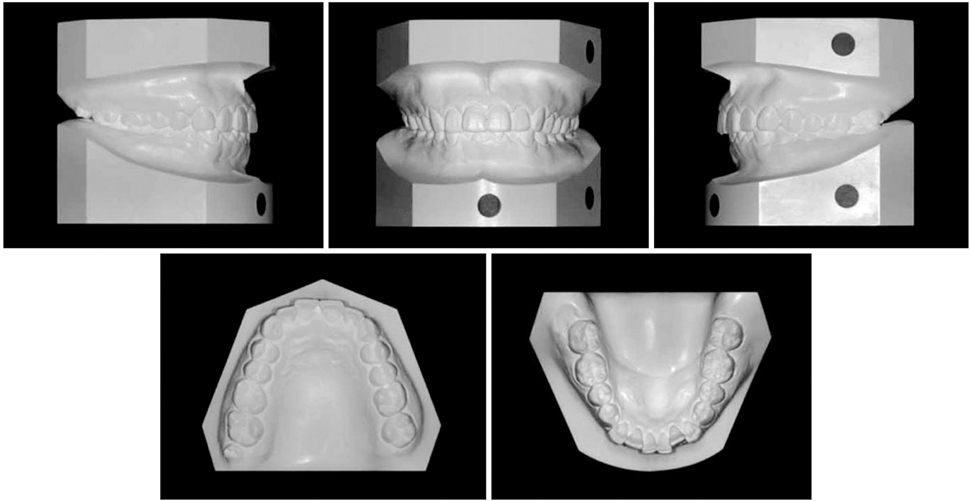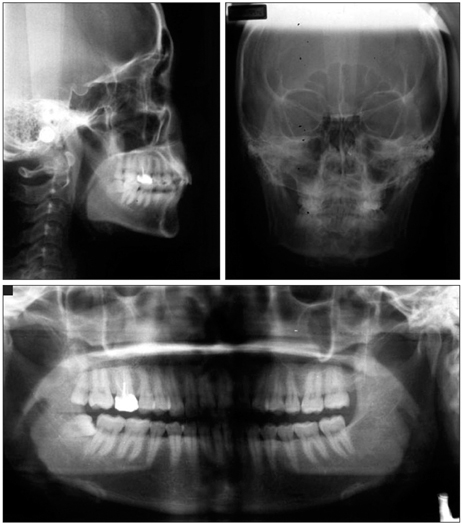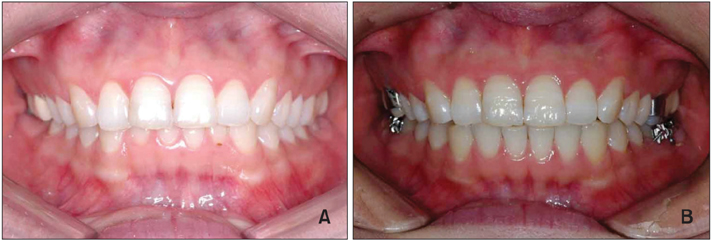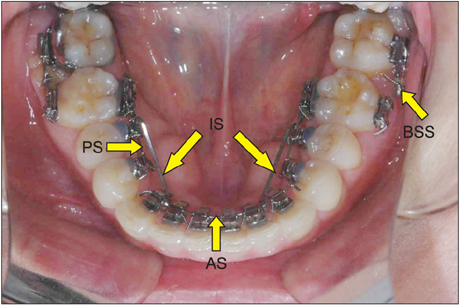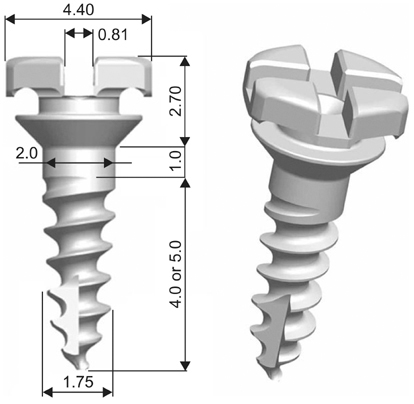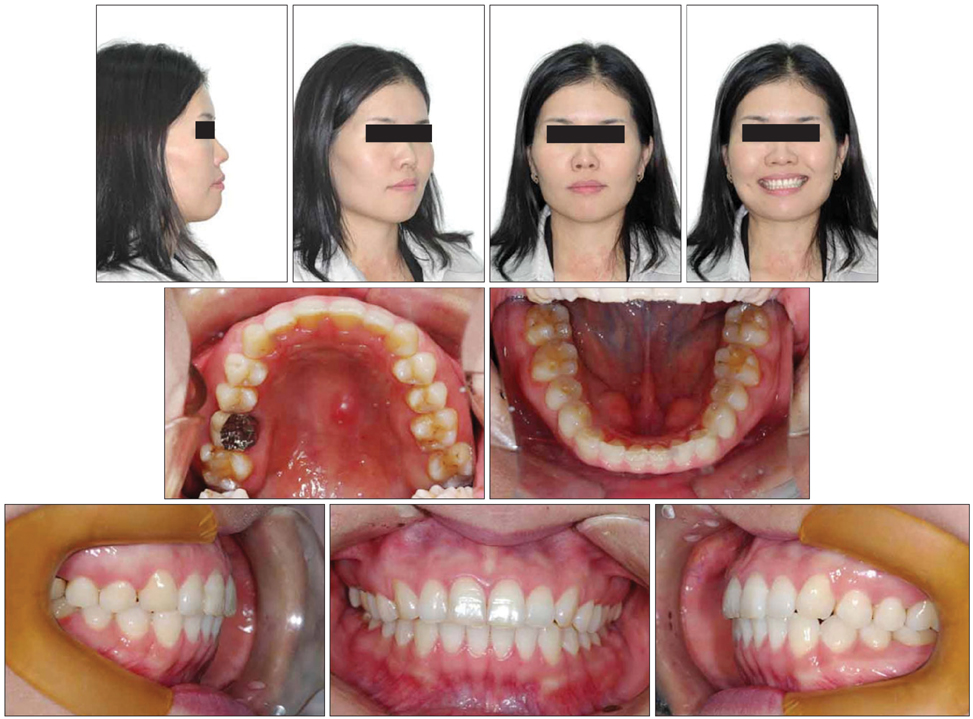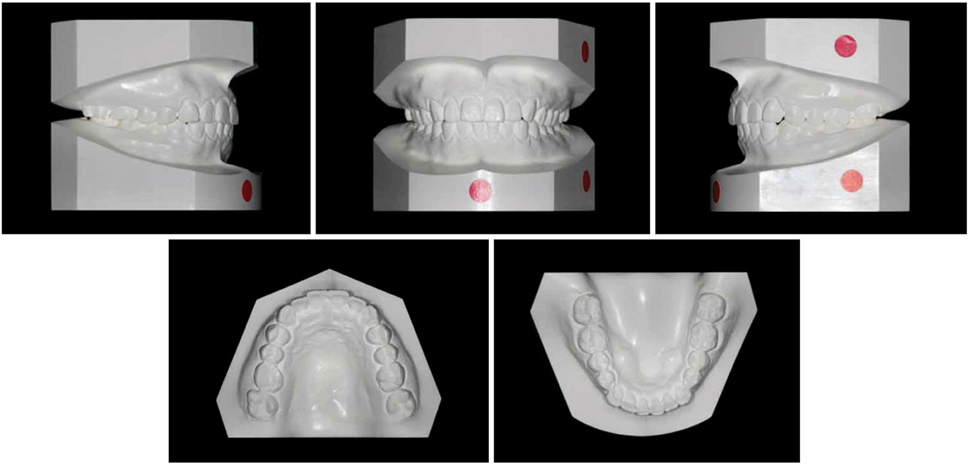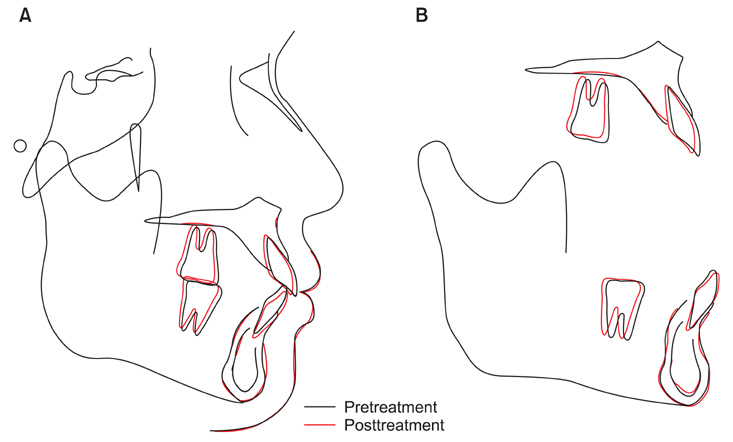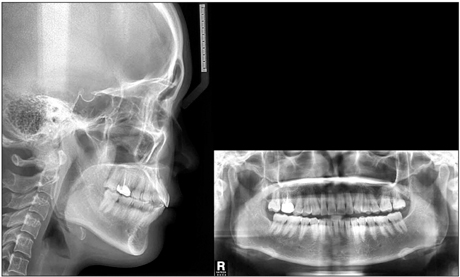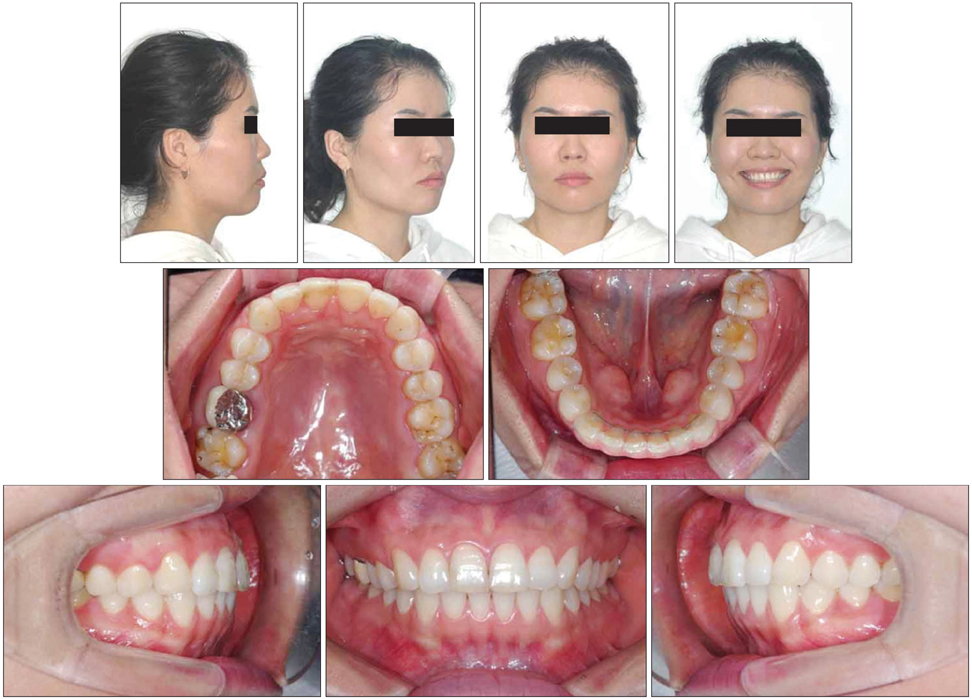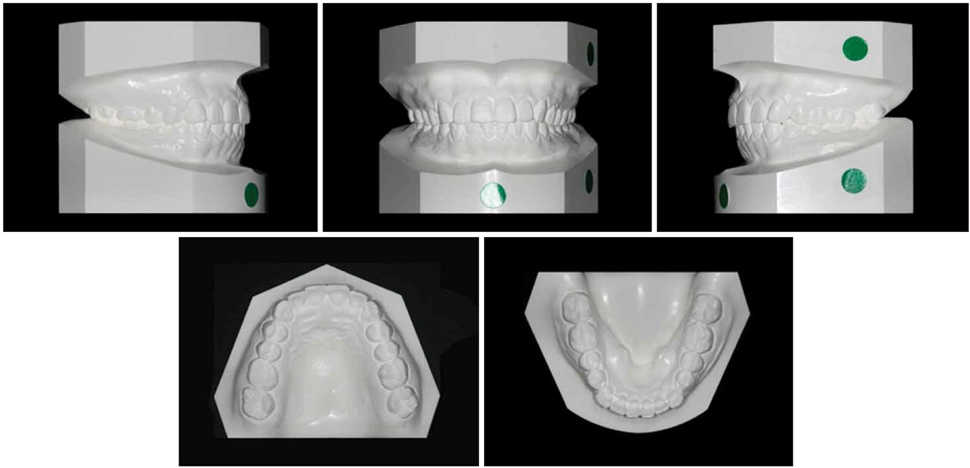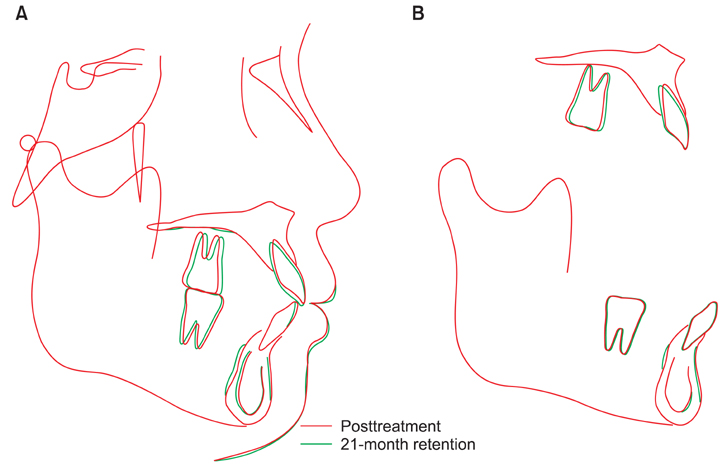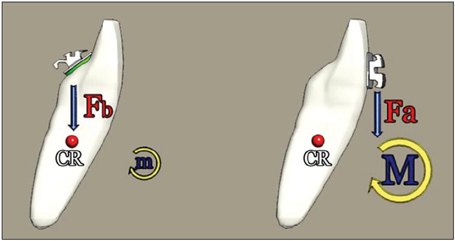Orthodontic treatment of gummy smile by maxillary total intrusion with a midpalatal absolute anchorage system
- Affiliations
-
- 1Department of Orthodontics, Chong-A Dental Hospital, Seoul, Korea. kloahong@naver.com
- 2Private Practice, Seoul, Korea.
- 3Department of Dentistry, Hallym University College of Medicine, Chuncheon, Korea.
- 4Department of Orthodontics, School of Dentistry, Dental Research Institute, Seoul National University, Seoul, Korea.
- KMID: 1975130
- DOI: http://doi.org/10.4041/kjod.2013.43.3.147
Abstract
- This article describes the orthodontic treatment of a 31-year-old Korean female patient with gummy smile and crowding. The patient showed excessive gingival display in both the anterior and posterior areas and a large difference in gingival heights between the anterior and posterior teeth in the maxilla. To correct the gummy smile, we elected to intrude the entire maxillary dentition instead of focusing only on the maxillary anterior teeth. Alignment and leveling were performed, and a midpalatal absolute anchorage system as well as a modified lingual arch was designed to achieve posterosuperior movement of the entire upper dentition. The active treatment period was 18 months. The gummy smile and crowding were corrected, and the results were stable at 21 months post-treatment.
Keyword
Figure
Cited by 3 articles
-
Displacement pattern of the anterior segment using antero-posterior lingual retractor combined with a palatal plate
Kyung-Won Seo, Soon-Yong Kwon, Kyung A Kim, Ki-Ho Park, Seong-Hun Kim, Hyo-Won Ahn, Gerald Nelson
Korean J Orthod. 2015;45(6):289-298. doi: 10.4041/kjod.2015.45.6.289.Nonsurgical correction of a severe anterior deep overbite accompanied by a gummy smile and posterior scissor bite using a miniscrew-assisted straight-wire technique in an adult high-angle case
Xue-Dong Wang, Jie-Ni Zhang, Da-Wei Liu, Fei-fei Lei, Yan-Heng Zhou
Korean J Orthod. 2016;46(4):253-265. doi: 10.4041/kjod.2016.46.4.253.Lip repositioning with or without myotomy: a systematic review
Mohammadreza Talebi Ardakani, Anahita Moscowchi, Nasrin Keshavarz Valian, Elham Zakerzadeh
J Korean Assoc Oral Maxillofac Surg. 2021;47(1):3-14. doi: 10.5125/jkaoms.2021.47.1.3.
Reference
-
1. Creekmore TD, Eklund MK. The possibility of skeletal anchorage. J Clin Orthod. 1983. 17:266–269.2. Kim TW, Kim H, Lee SJ. Correction of deep overbite and gummy smile by using a mini-implant with a segmented wire in a growing Class II Division 2 patient. Am J Orthod Dentofacial Orthop. 2006. 130:676–685.
Article3. Lin JC, Liou EJ, Bowman SJ. Simultaneous reduction in vertical dimension and gummy smile using miniscrew anchorage. J Clin Orthod. 2010. 44:157–170.4. Hong RK, Sohn HW. Update on the Fujita lingual bracket. J Clin Orthod. 1999. 33:136–142.5. Hong RK, Kim YH, Park JY. A new customized lingual indirect bonding system. J Clin Orthod. 2000. 34:456–460.6. Hong RK, Kim TG, Lim SM, Lee CH. Modified intrusive mechanics in lingual segmented-arch treatment. J Clin Orthod. 2005. 39:489–495.7. Robbins JW. Differential diagnosis and treatment of excess gingival display. Pract Periodontics Aesthet Dent. 1999. 11:265–272.8. Burstone CR. Deep overbite correction by intrusion. Am J Orthod. 1977. 72:1–22.
Article9. Redlich M, Mazor Z, Brezniak N. Severe high Angle Class II Division 1 malocclusion with vertical maxillary excess and gummy smile: a case report. Am J Orthod Dentofacial Orthop. 1999. 116:317–320.
Article10. Billiet T, de Pauw G, Dermaut L. Location of the centre of resistance of the upper dentition and the nasomaxillary complex. An experimental study. Eur J Orthod. 2001. 23:263–273.
Article11. Wehrbein H, Feifel H, Diedrich P. Palatal implant anchorage reinforcement of posterior teeth: A prospective study. Am J Orthod Dentofacial Orthop. 1999. 116:678–686.
Article12. Byloff FK, Kärcher H, Clar E, Stoff F. An implant to eliminate anchorage loss during molar distalization: a case report involving the Graz implant-supported pendulum. Int J Adult Orthodon Orthognath Surg. 2000. 15:129–137.13. Bernhart T, Freudenthaler J, Dörtbudak O, Bantleon HP, Watzek G. Short epithetic implants for orthodontic anchorage in the paramedian region of the palate. A clinical study. Clin Oral Implants Res. 2001. 12:624–631.
Article14. Kyung SH, Hong SG, Park YC. Distalization of maxillary molars with a midpalatal miniscrew. J Clin Orthod. 2003. 37:22–26.15. Lee JS, Kim DH, Park YC, Kyung SH, Kim TK. The efficient use of midpalatal miniscrew implants. Angle Orthod. 2004. 74:711–714.16. Park HS. A miniscrew-assisted transpalatal arch for use in lingual orthodontics. J Clin Orthod. 2006. 40:12–16.17. Kuroda S, Sakai Y, Tamamura N, Deguchi T, Takano-Yamamoto T. Treatment of severe anterior open bite with skeletal anchorage in adults: comparison with orthognathic surgery outcomes. Am J Orthod Dentofacial Orthop. 2007. 132:599–605.
Article18. Lee HA, Park YC. Treatment and posttreatment changes following intrusion of maxillary posterior teeth with miniscrew implants for open bite correction. Korean J Orthod. 2008. 38:31–40.
Article19. Baek MS, Choi YJ, Yu HS, Lee KJ, Kwak J, Park YC. Long-term stability of anterior open-bite treatment by intrusion of maxillary posterior teeth. Am J Orthod Dentofacial Orthop. 2010. 138:396.e1–396.e9.
Article20. Ohtani N. A study of the relapse movement of the intruded teeth and the effects of mechanical retention and gingival transection (author's transl). Nihon Kyosei Shika Gakkai Zasshi. 1980. 39:390–406.
- Full Text Links
- Actions
-
Cited
- CITED
-
- Close
- Share
- Similar articles
-
- Nonsurgical correction of a severe anterior deep overbite accompanied by a gummy smile and posterior scissor bite using a miniscrew-assisted straight-wire technique in an adult high-angle case
- Total intrusion and distalization of the maxillary arch to improve smile esthetics
- A study on the treatment of anterior open bite with midpalatal miniscrews
- Intrusion of the extruded maxillary central incisor using skeletal anchorage system and unilateral segmental intrusion arch
- Treatment of gummy smile using botulinum toxin: a review


